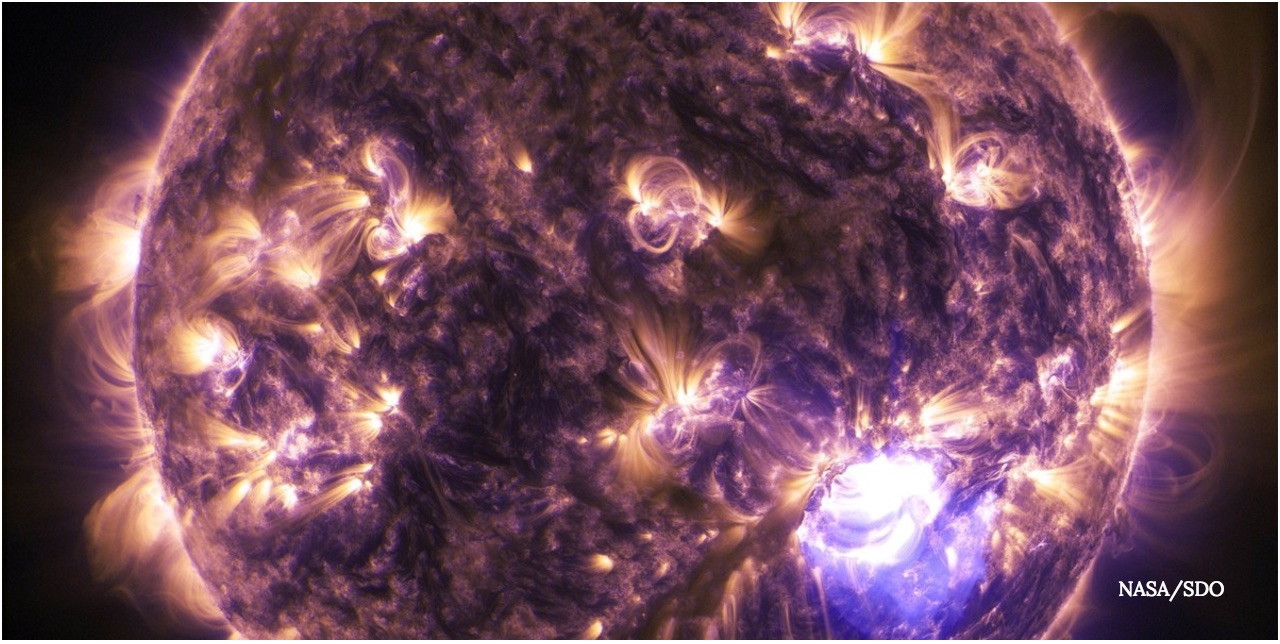Einstein's Theory Just Put the Brakes on the Sun's Spin

Although the sun is our nearest star, it still hides many secrets. But it seems that one solar conundrum may have been solved and a theory originally proposed in 1905 by Albert Einstein could be at the root of it all.
Twenty years ago, solar astronomers realized that the uppermost layer of the sun rotates slower than the rest of the sun's interior. This is odd. It is well known the sun rotates faster at its equator than at its poles — a phenomenon known as "differential rotation" that drives the sun's 11-year solar cycle — but the fact that the sun has a sluggish upper layer has been hard to understand. It's as if there's some kind of force trying to hold it in place while the lower layers churn below it.
Now, researchers from University of Hawaii Institute for Astronomy (IfA), Brazil, and Stanford University may have stumbled on an answer and it could all be down to fundamental physics. It seems that the light our sun generates has a braking effect on the sun's surface layers.
RELATED: Visualizing Our Sun's Messy Magnetic Mystery
"The sun won't stop spinning anytime soon, but we've discovered that the same solar radiation that heats the Earth is 'braking' the sun because of Einstein's Special Relativity, causing it to gradually slow down, starting from its surface," said Jeff Kuhn, of IfA Maui, in a statement.
Special relativity predicts that photons, which carry the electromagnetic force (i.e. light), also carry a tiny amount of momentum. If you have enough photons travelling away from an object, they will carry away a large amount of momentum. In the case of the sun's 4 billion year lifetime, the surface has lost a lot of momentum to photons, causing a slowdown of the uppermost 5 percent of the sun. This mechanism, called the Poynting-Robertson effect, has been observed in interplanetary dust, which feels the drag of the sun's radiation, causing it to fall from the asteroid belt into the inner solar system.
What affects dust inevitably affects the soup of super-heated gas in the sun's upper layers and, over its lifetime, the drag caused by photons being emitted from the sun has created a measurable and, until now, mysterious effect.
Get the Space.com Newsletter
Breaking space news, the latest updates on rocket launches, skywatching events and more!
Using several years of data from NASA's Solar Dynamics Observatory (SDO), the researchers were able to measure waves traveling through the sun to precisely measure the size of the layer that is experiencing this slowdown. The technique, known as "helioseismology," is very similar to measuring the seismic waves travelling through the Earth to measure the strength of an earthquake. The material these seismic waves travel through changes the waves so seismologists can "see" underground.
RELATED: Our Planet's Magnetism Saved It From Solar Sterilization
Though the sun isn't a solid planet made from rock and metal, its dense plasma interior also allows waves to travel, creating oscillations on the surface that can be measured. Helioseismology therefore allows astronomers to "see" into our nearest star, revealing many details about its interior that may not be obvious on the surface. And in this case, by using helioseismology and studying the sun's magnetic field passing from space into the sun's interior, we can gauge how much of a drag Einstein's special relativity has had on the sun's surface.
"This is a gentle torque that is slowing it down, but over the Sun's 5 billion year lifetime it has had a very noticeable influence on its outer 35,000 kilometers [22,000 miles]," said Kuhn. These findings have accepted for publication in the journal Physical Review Letters and can be previewed on the arXiv pre-print service.
Using our sun as a laboratory for other stars, Kuhn's team believe that a similar effect likely happens for all stars and could have a strong influence on stellar evolution. Now solar astronomers are very interested to understand how this solar slowdown impacts the sun's magnetic field that threads through the entire solar system. As the sun's magnetism is the root cause of space weather that can trigger solar flares and coronal mass ejections that could interfere with satellites and power grids, this research could have a key role to play in our understanding of solar impacts on Earth.
Originally published on Seeker.
Join our Space Forums to keep talking space on the latest missions, night sky and more! And if you have a news tip, correction or comment, let us know at: community@space.com.
Ian O'Neill is a media relations specialist at NASA's Jet Propulsion Laboratory (JPL) in Southern California. Prior to joining JPL, he served as editor for the Astronomical Society of the Pacific‘s Mercury magazine and Mercury Online and contributed articles to a number of other publications, including Space.com, Space.com, Live Science, HISTORY.com, Scientific American. Ian holds a Ph.D in solar physics and a master's degree in planetary and space physics.









